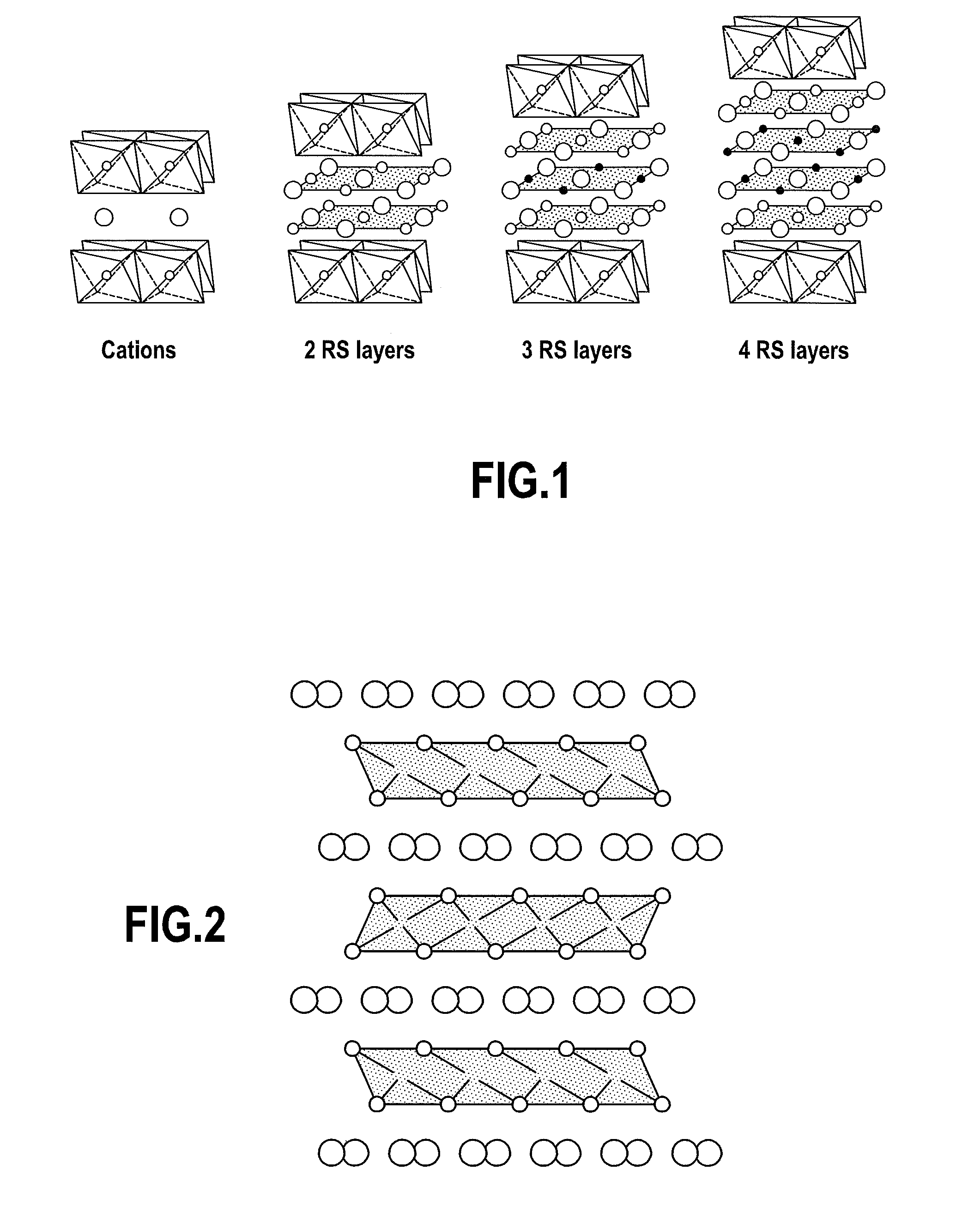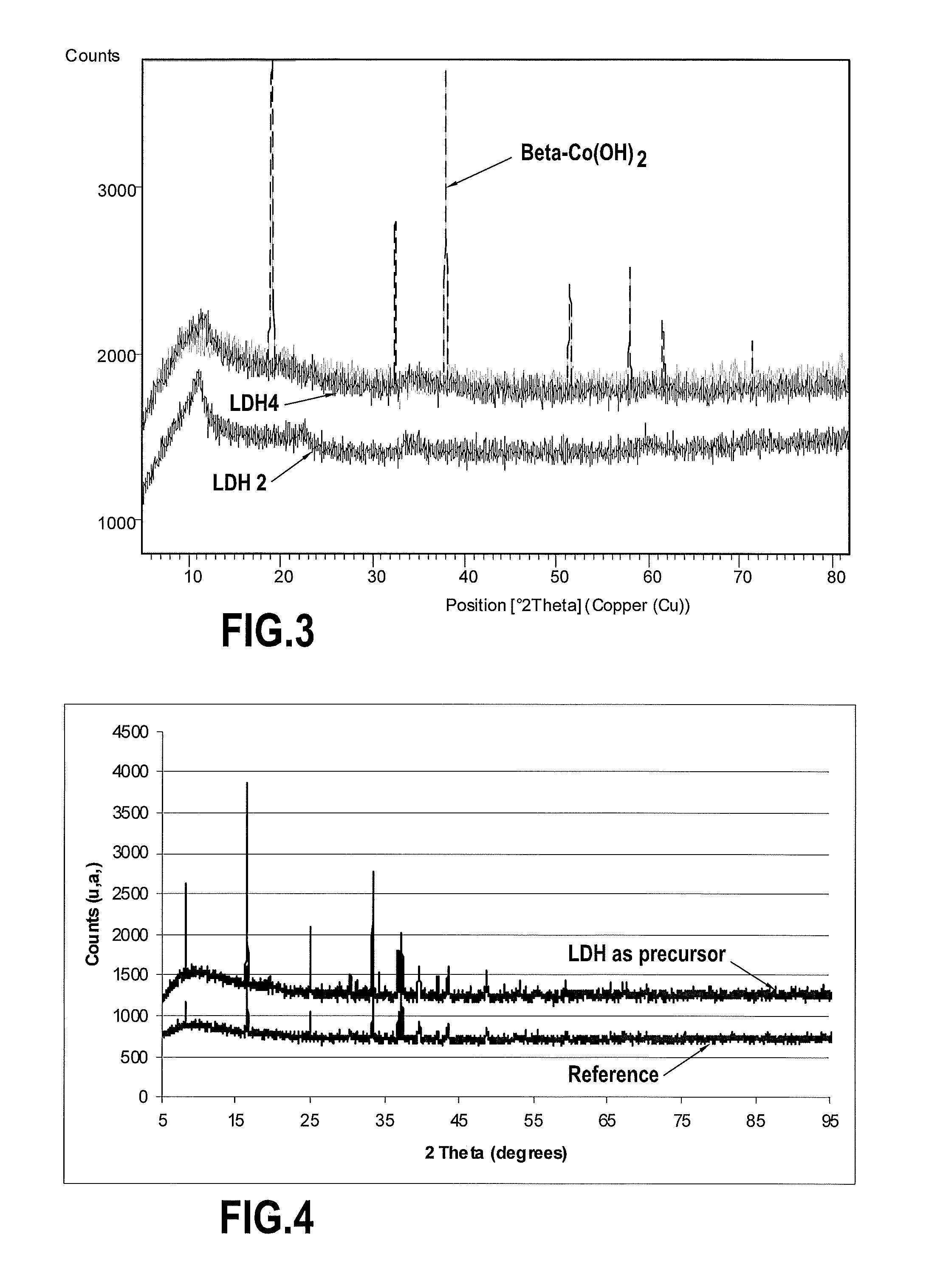Process for synthesizing layered oxides
- Summary
- Abstract
- Description
- Claims
- Application Information
AI Technical Summary
Benefits of technology
Problems solved by technology
Method used
Image
Examples
example 1
Synthesis of a CoIICoIII LDH
[0053]An aqueous solution was prepared, containing 0.01 mole of cobalt nitrate (Co(NO3)2.6H2O, VWR, 99.7% purity) and 10 g of PEG (Aldrich) in 50 ml of water. A 20% NH3 solution (Fischer) was added dropwise to the above-mentioned aqueous solution at a constant rate through a peristaltic pump, according to the varying pH method (as described in Journal of Physics and Chemistry of Solids 2008, 69(5-6), 1088-1090). The pH was monitored by a pH-meter (Mettler DL67 Titrator) and the experiment was stopped when the pH reached a value of 9.
[0054]The resulting slurry was aged under vigorous stirring during 24 h at room temperature, and then centrifuged at 4000 rpm during 5 min (Eppendorf Centrifuge 5403). The supernatant was removed and the residue was washed three times with deionized water at room temperature, then dried overnight in a furnace at 60° C. (Binder).
[0055]FIG. 3 shows the X-ray diffraction pattern of the resulting powder (LDH2), compared to that of...
example 2
Synthesis of a CoIICoIII LDH
[0056]A first aqueous solution was prepared, containing 0.01 mole of cobalt nitrate (Co(NO3)2.6H2O, VWR, 99.7% purity) in 50 ml of water. A second solution was prepared by introducing 280 ml of a 3.5 M NaOH solution (solid NaOH from Fischer (98%)) in 1000 ml of a 1M Na2CO3 solution (Merck, 99.5%). The second solution was added dropwise to the first solution at a constant rate through a peristaltic pump, according to the varying pH method (as described in Journal of Physics and Chemistry of Solids 2008, 69(5-6), 1088-1090). The pH was monitored by a pH-meter (Mettler DL67 Titrator) and the experiment was stopped when the pH reached a value of 9.
[0057]The resulting slurry was aged under vigorous stirring during 24 h at room temperature, and then centrifuged at 4000 rpm during 5 min (Eppendorf Centrifuge 5403). The supernatant was removed and the residue was washed three times with deionized water at room temperature, then dried overnight in a furnace at 60°...
example 3
Synthesis of Ca3Co4O9
[0059]Stoichiometric amounts of the CoIICoIII LDH of example 2 and of CaCO3 (Sigma Aldrich, >99% purity) were thoroughly mixed for 5 min at 400 rpm in an agate ball mill (Retsch PM 100). The resulting powder was heated at 850° C. for 8 h in an alumina crucible at a rate of 5° C. / min and then slowly cooled down, whereby a powdered oxide was obtained. Sintering was then performed by Spark Plasma Sintering (SPS, FCT Systeme GmbH HP D 25) as follows. The powdered oxide was placed in a 20 mm diameter graphite die. A pressure of 70 MPa was applied whereas the temperature was raised at 100° C. / min up to 850° C. for 5 minutes. Then the sample was cooled at 100° C. / min to room temperature. The obtained pellets were then polished to remove the graphite foils used during the SPS process and cut as bars for thermoelectric properties measurements or core drilled (12.7 mm diameter, 2 mm in thickness) for thermal conductivity measurements.
[0060]FIG. 4 shows that this oxide ex...
PUM
 Login to View More
Login to View More Abstract
Description
Claims
Application Information
 Login to View More
Login to View More - R&D
- Intellectual Property
- Life Sciences
- Materials
- Tech Scout
- Unparalleled Data Quality
- Higher Quality Content
- 60% Fewer Hallucinations
Browse by: Latest US Patents, China's latest patents, Technical Efficacy Thesaurus, Application Domain, Technology Topic, Popular Technical Reports.
© 2025 PatSnap. All rights reserved.Legal|Privacy policy|Modern Slavery Act Transparency Statement|Sitemap|About US| Contact US: help@patsnap.com



